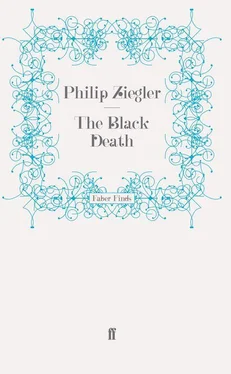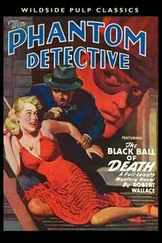And then, in the Great War, the warring nations knew their enemies and knew, too, that they were merely mortal. They had a defined target to hate and to contend with. The plague victim could hate only his God or himself, with occasional not wholly convincing forays in persecution of Jews, lepers or other even less substantial surrogates. For the rest his affliction was totally mysterious and far the more dreadful for being so. And finally the Great War was spread over more than four years; for each locality the great pestilence worked its mischief in a tenth the time. It can be argued that protracted agony is worse than a sudden and explosive shock, but if one is considering the impact on the mind of the survivor then it is surely the second which will produce the graver consequences.
The ‘shell-shock’ which Mr Thompson finds in the survivors of the two catastrophes should therefore have been more violent and more lasting among those who endured the Black Death. But is this not particularly striking generalization of any value? What form did the ‘shell-shock’ take? Was it the kind of shock which galvanized into action or which stunned into apathy? Is it possible to detect any significant and consistent change in the attitude of medieval man between the first and second halves of the fourteenth century? Does the statement that modern man was forged in the crucible of the Black Death have any real validity? Does it, indeed, mean anything at all?
To some at least of these questions this book may provide a tentative answer. But it is only necessary to pose them to see how far we are, and will always be from a definitive solution. In a field so amorphous any attempt at the precise or the categoric would be futile. But if one were to seek to establish one generalization, one cliché perhaps, to catch the mood of the Europeans in the second half of the fourteenth century, it would be that they were enduring a crisis of faith. Assumptions which had been taken for granted for centuries were now in question, the very framework of men’s reasoning seemed to be breaking up. And though the Black Death was far from being the only cause, the anguish and disruption which it had inflicted made the greatest single contribution to the disintegration of an age.
Faith disappeared, or was transformed; men became at once sceptical and intolerant. It is not at all the modern, serenely cold, and imperturbable scepticism; it is a violent movement of the whole nature which feels itself impelled to burn what it adores; but the man is uncertain in his doubt, and his burst of laughter stuns him; he has passed as it were, through an orgy, and when the white light of the morning comes he will have an attack of despair, profound anguish with tears and perhaps a vow of pilgrimage and a conspicuous conversion. {532}
Jusserand’s classic description of the European in the second half of the fourteenth century captures admirably the twin elements of scepticism and timorous uncertainty. The generation that survived the plague could not believe but did not dare deny. It groped myopically towards the future, with one nervous eye always peering over its shoulder towards the past. Medieval man during the Black Death, had seemed as if silhouetted against a background of Wagnerian tempest. All around him loomed inchoate shapes redolent with menace. Thunder crashed, lightning blazed, hail cascaded; evil forces were at work, bent on his destruction. He was no Siegfried, no Brunnhilde heroically to defy the elements. Rather, it was as if he had wandered in from another play: an Edgar crying plaintively, ‘Poor Tom’s a-cold; poor Tom’s a-cold!’ and seeking what shelter he could against the elements.
Poor Tom survived, but he was never to be quite the same again.
THERE are remarkably few full-length studies dealing with the Black Death as a whole or even in a country or group of countries. The most important of these is still that by Cardinal Gasquet though many of his facts have now been disproved and his conclusions shown to be invalid. Sticker’s study gives the widest coverage for Europe as a whole and Hoeniger’s for Germany. The others are of slight importance.
• Coulton. G. G. The Black Death, London, 1929.
• Gasqute, F. A. The Great Pestilence, London, 1893. Reprinted substantially unrevised as The Black Death, London, 1908
• Hecker. J. F. C. The epidemics of the Middle Ages, trad. Babington. London, 1859.
• Hoeniger, R. Der Schwarze Tod in Deuuschland, Berlin. 1882.
• Lechner, K. Das Grosse Sterben in Deutschland, Innsbruck, 1884
• Nohl. J. Der Schwarze Tod, Potsdam, 1924.
• Philippe, A. Histoire de la Peste Noire, Paris, 1853.
• Sticker, G. Die Pest, Vol. 1, (‘Die Geschichte der Pest’), Giessen, 1908.
More useful material on a national or international scale is often to be found in books not dealing exclusively with the Black Death (Coulton’s Mediaeval Panorama, for instance, contains more of value than his monograph mentioned above) or in more recent essays and articles. In this and subsequent sections I have marked with an asterisk sources of particularly valuable information.
• Carpentier, E.* ‘Autour de la Peste Noire’, Annales E.S.C., 1962, XVII, p. 1062.
• Coulton, G. G.* Mediaeval Panorama, Cambridge, 1938, Chap. 38.
• Doren, A. Storia Economica dell’ Italia nel Medio Evo, Padua, 1937.
• Duby, G. L’Économie rural et la vie des campagnes dans l’Occident médiéval, Paris, 1962.
• Gwynn, A. ‘The Black Death in Ireland’, Studies, 1935, Vol. XXIV, p. 25.
• Maycock, A. L. ‘A Note on the Black Death’, Nineteenth Century, 1925, Vol. XCVII, p. 456.
• Rees, W.* ‘The Black Death in Wales’, Trans. Roy. Hist Soc., Fourth Series, 1920, Vol. III, p. 115.
• Rees, W. ‘The Black Death in England and Wales as exhibited in Manorial Documents’, Proc. Roy. Soc. Med. Vol. 16, Pt. 2, p. 27.
• Renouard, Y.* ‘La Peste Noire,’ Revue de Paris, March 1950, p. 107.
• Rogers, J. E. Thorold ‘England before and after the Black Death’, Fortnightly Review, 186s, Vol. III, p. 191.
• Ruthven, O. History of Medieval Ireland, London, 1968.
• Seebohm, F. ‘The Black Death, and its place in English History’, Fortnightly Review, 1865, Vol. II, pp. 149 and 268.
• Seebohm, F. ‘The Population of England before the Black Death’, Fortnightly Review, 1866, Vol. IV, p. 87.
• Verlinden, C. ‘La Grande Peste de 1348 en Espagne’, Revue belge de Philologie et d’Histoire, 1938, XVII, p.103.
Among works on epidemiology, medical history or bubonic plague, those of particular relevance to the Black Death are:
• Anglada, A. Études sur les Maladies Éteintes, Paris, 1869.
• Creighton, C. A History of Epidemics in Britain, Cambridge, 1891.
• Greenwood,* Major Epidemics and Crowd Diseases, London, 1935.
• Hirst, L.F.* The Conquest of Plague, Oxford, 1953.
• John. F. M. The Block Death, London, 1920.
• Liston, W. G. ‘The Plague’, Brit. Med. Journ., 1924, Vol. I, pp. 900, 950 and 997.
• MacArthur, W. ‘Old Time Plague in Britain’, Trans. Roy. Soc. Trop. Med. Hyg., Vol. XIX, p. 355.
• Mullett, C. F. The Bubonic Plague and England, Lexington, 1956.
• Papon, J. P. De la Peste ou Epoques Mémorables de ce Fléau, Paris, 1800.
• Pollitzer, R.* Plague, W.H.O., Geneva, 1954. Rebouis, H. E. Étude historique et critique sur la peste, Paris, 1888.
Читать дальше












